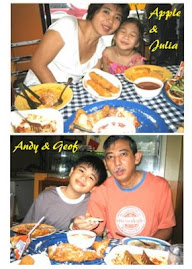The legend is true: everything is expensive in Tokyo. That is, if you don't know where to look. Being in Tokyo for more than 6 weeks now, I've discovered some places where you can find not- so-expensive items.

1. Musashi-Koyama: The shopping area covers the whole street. Available are food stalls, shoes, house items, beauty products, Kimono shops, dried fish.
How to go there: From Meguro station (see Nambuko/green line station N-01 or Mita/Royal blue line station I-01), take the Meguro line going to the direction of Ookayama. Musashi Koyama is just 2 stations away from Meguro station.
2. Sugamo: This is an old-people's gathering area. The street market is only available 3 times a month - in every date where you find the number 4 (i.e. every 4th, 14th, and 24th of the month). The stalls, of course, are there the whole year round, with products the same as in the Musashi-koyama shopping street. But the street-vendors that sprout during the "number-4" days of the month sell food items that are not available in the regular stalls - vegetables, fruits, pickled veggies, sweetened fruits, street food, powdered (dried) snake and turtle, and other cooking ingredients that I have no idea about.
How to go there: Take the Mita/Royal blue line (station I-15) or the JR Yamanote line (station Sugamo).
3. Okachimachi: The items you'll find here are are the same as Sugamo and Mushashi-Koyama except that here there are fresh meat items, mostly sea produce (different kinds of fish, crabs, octopus)
How to go there: Take the Oedo/ Pink line (station E-09), or the Ginza/ Orange line (station G-15) or Hibiya/ Gray line (station H-16), or the JR Yamanote line (station Okachimachi). The street-shopping area is actually just below the JR Yamanote train.
4. Ueno: One station away from Okachimachi is Ueno. In fact, the shopping street of Okachimachi and Ueno are connected so most of the items in both areas are the same. But it was in Ueno that I found a shop run by an old couple, and sells souvenirs that are reflective of the Japanese colors, images, and textures.
How to go there: Take the Ginza/ Orange line (station G-16), or Hibiya/ Gray line (station H-17) or the JR Yamanote line (station Keisei-Ueno).
5. Asakusa: This is also known as the Old Edo (Tokyo). The shopping area is the street that leads to the Asakusa shrine. So the idea is to shop before or after visiting the shrine. Most of the items that are found here are souvenir items, sweets, and street food.
How to go there: Take the Ginza/ Orange line (station G-19) or Asakusa/ Red Orange line (station A-18).

Asakusa Shrine
As mentioned, most of the items available in these areas are very similar with each other -and the good thing is the prices of the same-type-items are also standard, save of course for some.
The trick, therefore, is to find the needle in the hay stalk. There are some shops that stand out in these places, but one must be prepared to engage in the routine I call "walk and check, walk and check."
Happy shopping!



















